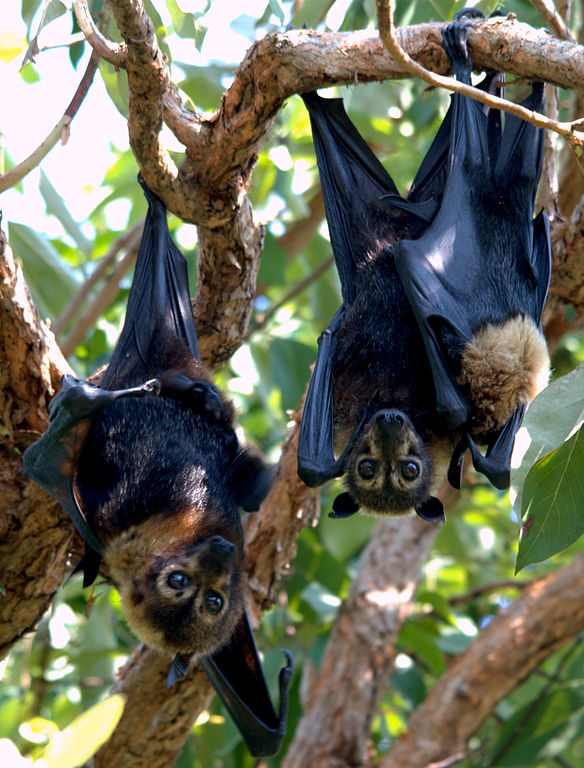Critter Corner – The Spectacled Flying Fox
#CritterCorner – One of the favourite creatures of Far North Queensland, the Spectacled Flying Fox is an essential part of the rainforest’s web of life. The greatest threats to these rainforest pollinators and gardeners is loss of habitat through development, culling by farmers with permits granted by the Qld Government, and climate change. Recent extreme temperatures in Far North Queenland resulted in significant numbers of these megabats succumbing to the heat.
Rainforest Rescue is proud of our partnership with NightWings Rainforest & Bat Rehabilitation centre. Together we are restoring legacy cane plantation to rainforest, bat-friendly habitat. Learn more about NightWings by visiting their website or Facebook page.
From Wikipedia:
“The species is part of Organization for Bat Conservation‘s many international conservation projects.
In 2012, the Queensland Government reintroduced the issuing of permits which allows farmers and fruit-growers (with permits) to kill limited numbers of flying foxes in order to protect crops.[12][13] The shooting of bats had been banned by the previous Qld Labor government after advice from the Qld Animal Welfare Advisory Committee (AWAC) that the practice was inhumane.
In February 2019, the Australian Department of the Environment and Energy announced that the national status of the spectacled flying fox was going to be revised from vulnerable to endangered. This was in response to heat waves in the 2018-19 summer that resulted in mass die-offs of the species, resulting in the deaths of over 20,000 individuals. It is estimated that a third of its total population was lost during the extreme heat waves. Humane Society International had nominated the species for an endangered listing some months earlier.[4] ”
Family: Pteropodidae:Chiroptera:Mammalia:Chordata:Animalia
Scientific Name: Pteropus conspicillatus
Common Name: Spectacled Flying-fox
- The Spectacled Flying-fox is listed as vulnerable, being revised to endangered
- Throughout the Wet Tropics, Whybird and colleagues (2000 cited in McIlwee & Martin 2002) noted a loss of 15 permanent camps (a total population of 610 000 individuals) between 1985 and 2000. The Spectacled Flying-fox population declined from an estimated 820 000 in 1985 to 80 000 in November 2000 (Whybird 2001, pers. comm. cited in McIlwee and Martin 2002). This indicates an approximate 78% population decline over the fifteen-year period between 1985 and 2000 (Whybird et al. 2000 cited in McIlwee & Martin 2002). The population was recorded as having declined by 35% over the two years between 1998 and 2000 (DEH 2003d)
- These bats occur in NE Qld (restricted to tropical rainforest areas) – with the wet tropics containing the largest population in Australia. They can also be found in Torres Strait Islands, Papua New Guinea and nearby islands, parts of Indonesia & Solomon Islands
- Their head and body ranges between 220 mm -240 mm in length, forearm length and weight range is 160-180 mm and 580-850 g for males, and 155-175 mm and 500-650 g for females
- Their wingspans can reach up to 1.6 metres
- Spectacled Flying-foxes have pale, straw-coloured fur around their eyes that look like a pair of spectacles, hence the name
- They are called flying foxes because of their large eyes, pricked ears and long snouts that make them look a little bit like a dog or fox
- The Spectacled Flying-fox has been demonstrated to have the greatest tolerance to ranges of ambient temperature of any mammal
- Spectacled Flying-foxes give birth to one pup annually. Females are capable of breeding at one year of age but in captivity few of these young survive
- The natural lifespan is not known although one captive individual reached 17 years of age
- Spectacled Flying-foxes distribute seeds which helps the rainforest regenerate
- They are vegetarians – eating a diet consisting mainly of nectar and fruit
- They spend the day in communal tree-top camps found in the upper canopy of tall trees in rainforest, freshwater swamps and mangroves
- The Spectacled Flying-fox is part of the Megabat family and don’t use sonar or echolocation, instead depending on vision and excellent sense of smell
- Threats include habitat loss, tick paralysis, disturbance of camps, competition, environmental stress, cyclones, man made obstacles such as powerlines/barbwire/traffic, human activity and cleft palate syndrome
Sources: Department of Environment and Wet Tropics Management Authority
Want more good Rainforest news in your life?
Subscribe to our eNews | Follow us on Instagram | Like us on Facebook | Subscribe to our YouTube channel
Help Protect Rainforests Forever
Donate to Protect Rainforests Forever | Become a Rainforest Guardian for as little as $2 a month | Partnership Options


